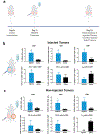SQ3370 Activates Cytotoxic Drug via Click Chemistry at Tumor and Elicits Sustained Responses in Injected & Non-injected Lesions
- PMID: 33869738
- PMCID: PMC8049173
- DOI: 10.1002/adtp.202000243
SQ3370 Activates Cytotoxic Drug via Click Chemistry at Tumor and Elicits Sustained Responses in Injected & Non-injected Lesions
Abstract
While systemic immuno-oncology therapies have shown remarkable success, only a limited subset of patients benefit from them. Our Click Activated Protodrugs Against Cancer (CAPAC™) Platform is a click chemistry-based approach that activates cancer drugs at a specific tumor with minimal systemic toxicity. CAPAC Platform is agnostic to tumor characteristics that can vary across patients and hence applicable to several types of tumors. We describe the benefits of SQ3370 (lead candidate of CAPAC) to achieve systemic anti-tumor responses in mice bearing two tumors. SQ3370 consists of a biopolymer, injected in a single lesion, followed by systemic doses of an attenuated protodrug™ of doxorubicin (Dox). SQ3370 was well-tolerated at 5.9-times the maximum dose of conventional Dox, increased survival by 63% and induced a systemic anti-tumor response against injected and non-injected lesions. The sustained anti-tumor response also correlated with immune activation measured at both lesions. SQ3370 could potentially benefit patients with micro-metastatic lesions.
Keywords: Bioorthogonal Chemistry; abscopal effect; anenestic response; immuno-oncology; local drug activation; platform technology.
Conflict of interest statement
Conflict of Interest S. Srinivasan, N. A. Yee, M. Zakharian, A. Mahmoodi, J. M. Mejia Oneto are paid employees and shareholders of Shasqi, Inc. (Shasqi). J.M. Mejia Oneto is the Founder and CEO of Shasqi. M. Royzen is a shareholder of Shasqi.
Figures








Similar articles
-
Click activated protodrugs against cancer increase the therapeutic potential of chemotherapy through local capture and activation.Chem Sci. 2021 Jan 5;12(4):1259-1271. doi: 10.1039/d0sc06099b. Chem Sci. 2021. PMID: 34163888 Free PMC article.
-
SQ3370, the first clinical click chemistry-activated cancer therapeutic, shows safety in humans and translatability across species.bioRxiv [Preprint]. 2023 Mar 29:2023.03.28.534654. doi: 10.1101/2023.03.28.534654. bioRxiv. 2023. PMID: 37034617 Free PMC article. Preprint.
-
A first-in-human, Phase 1/2a, open-label study of SQ3370, a first-in-class doxorubicin-based click chemistry therapeutic, in patients with advanced solid tumors.medRxiv [Preprint]. 2025 Jun 4:2025.06.02.25328445. doi: 10.1101/2025.06.02.25328445. medRxiv. 2025. PMID: 40502603 Free PMC article. Preprint.
-
Overview of resistance to systemic therapy in patients with breast cancer.Adv Exp Med Biol. 2007;608:1-22. doi: 10.1007/978-0-387-74039-3_1. Adv Exp Med Biol. 2007. PMID: 17993229 Review.
-
Immunodynamics: a cancer immunotherapy trials network review of immune monitoring in immuno-oncology clinical trials.J Immunother Cancer. 2016 Mar 15;4:15. doi: 10.1186/s40425-016-0118-0. eCollection 2016. J Immunother Cancer. 2016. PMID: 26981245 Free PMC article. Review.
Cited by
-
Designing Bioorthogonal Reactions for Biomedical Applications.Research (Wash D C). 2023 Dec 15;6:0251. doi: 10.34133/research.0251. eCollection 2023. Research (Wash D C). 2023. PMID: 38107023 Free PMC article. Review.
-
Recent Advances in the Development of Tetrazine Ligation Tools for Pretargeted Nuclear Imaging.Pharmaceuticals (Basel). 2022 May 30;15(6):685. doi: 10.3390/ph15060685. Pharmaceuticals (Basel). 2022. PMID: 35745604 Free PMC article. Review.
-
Clickable Polysaccharides for Biomedical Applications: A Comprehensive Review.Prog Polym Sci. 2022 Oct;133:101590. doi: 10.1016/j.progpolymsci.2022.101590. Epub 2022 Aug 9. Prog Polym Sci. 2022. PMID: 37779922 Free PMC article.
-
Tailor-Made Polysaccharides for Biomedical Applications.ACS Appl Bio Mater. 2024 Jul 15;7(7):4193-4230. doi: 10.1021/acsabm.3c01199. Epub 2024 Jul 3. ACS Appl Bio Mater. 2024. PMID: 38958361 Free PMC article. Review.
-
Click activated protodrugs against cancer increase the therapeutic potential of chemotherapy through local capture and activation.Chem Sci. 2021 Jan 5;12(4):1259-1271. doi: 10.1039/d0sc06099b. Chem Sci. 2021. PMID: 34163888 Free PMC article.
References
-
- Tian F; Lu Y; Manibusan A; Sellers A; Tran H; Sun Y; Phuong T; Barnett R; Hehli B; Song F; DeGuzman MJ; Ensari S; Pinkstaff JK; Sullivan LM; Biroc SL; Cho H; Schultz PG; di Joseph J; Dougher M; Ma D; Dushin R; Leal M; Tchistiakova L; Feyfant E; Gerber HP; Sapra P A General Approach to Site-Specific Antibody Drug Conjugates. Proceedings of the National Academy of Sciences of the United States of America 2014, 111 (5), 1766–1771. 10.1073/pnas.1321237111. - DOI - PMC - PubMed
Grants and funding
LinkOut - more resources
Full Text Sources
Other Literature Sources
